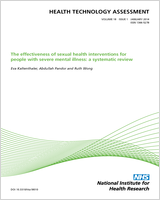Included under terms of UK Non-commercial Government License.
NCBI Bookshelf. A service of the National Library of Medicine, National Institutes of Health.
Headline
Study finds that routine use of transthoracic echocardiography following diagnosis of atrial fibrillation would identify pathologies in many patients, particularly with regard to valvular heart disease, ischaemic heart disease and heart failure. Economic modeling suggested that this approach is likely to be cost-effective.
Abstract
Objective:
To investigate the clinical effectiveness and cost-effectiveness of transthoracic echocardiography (TTE) in all patients who are newly diagnosed with atrial fibrillation (AF).
Design:
Narrative synthesis reviews were conducted on the prognostic and diagnostic accuracy of TTE for, and prevalence of, pathologies in patients with AF. Databases were searched from inception. MEDLINE searches were conducted from March to August 2010, and reference lists of articles checked. There were 44 diagnostic accuracy studies, five prognostic studies, and 16 prevalence studies accepted into the review. Given the complexity of the many pathologies identified by TTE, the variety of potential changes to clinical management, and paucity of data, the model focused on changes to oral anticoagulation (OAC). The mathematical model assessed the cost-effectiveness of TTE for patients with AF who were not routinely given OAC, assuming, if left atrial abnormality was detected, that the higher risk of stroke warranted OAC; this meant that patients with a CHADS2 (cardiac failure, hypertension, age, diabetes, stroke doubled) score of 0 [dabigatran etexilate (Pradaxa®, Boehringer Ingelheim)/rivaroxaban (Xarelto®, Bayer Schering)] or 0/1 (warfarin) were included. A simplified approach evaluated the additional quality-adjusted life-years (QALYs) required in order for TTE to be perceived as cost-effective at a threshold of £20,000 per QALY.
Setting:
Transthoracic echocardiography is usually performed in cardiology clinics but may be used in primary or non-specialist secondary care.
Participants:
Patients with newly diagnosed AF.
Intervention:
Transthoracic echocardiography.
Main outcome measures:
Prognosis, diagnostic sensitivity or specificity of TTE, prevalence of pathologies in patients with AF, cost-effectiveness and QALYs.
Results:
Prognostic studies indicated that TTE-diagnosed left ventricular dysfunction, increased left atrial diameter and valvular abnormality were significantly associated with an increased risk of stroke, mortality or thromboembolism. There was a high prevalence (around 25–30%) of ischaemic heart disease, valvular heart disease and heart failure in patients with AF. Diagnostic accuracy of TTE was high, with most pathologies having specificity of ≥ 0.8 and sensitivity of ≥ 0.6. The mathematical model predicted that when the CHADS2 tool is used the addition of TTE in identifying patients with left atrial abnormality appears to be cost-effective for informing some OAC decisions. In the simplified approach a threshold of 0.0033 was required for a TTE to be cost-effective.
Conclusions:
When CHADS2 was used, the addition of TTE in identifying patients with left atrial abnormality was cost-effective for informing some OAC decisions. A simple analysis indicates that the number of QALYs required for TTE to be cost-effective is small, and that if benefits beyond those associated with a reduction in stroke are believed probable then TTE is likely to be cost-effective in all scenarios. Our findings suggest that further research would be useful, following up newly diagnosed patients with AF who have undergone TTE, to study treatments given as a result of TTE diagnoses and subsequent cardiovascular events. This could identify additional benefits of routine testing, beyond stroke prevention. Studies assessing the proportion of people with a CHADS2 score of 0 or 1 that have left atrial abnormality would provide better estimates of the cost-effectiveness of TTE, and allow more accurate estimates of the sensitivity and specificity of TTE for identifying left atrial abnormality in AF to be obtained.
Study registration:
PROSPERO CRD42011001354.
Funding:
The National Institute for Health Research Health Technology Assessment programme.
Contents
- Scientific summary
- Chapter 1. Background
- Chapter 2. Definition of the decision problem
- Chapter 3. Assessment of clinical effectiveness
- Chapter 4. Simulating clinical events and estimating cost-effectiveness ratios
- Chapter 5. Assessment of factors relevant to the NHS and other parties
- Chapter 6. Discussion and conclusions
- Acknowledgements
- References
- Appendix 1 Inclusion and exclusion of pathologies
- Appendix 2 Diagnosis of pathologies
- Appendix 3 Search strategies
- Appendix 4 Data abstraction tables: diagnostic review
- Appendix 5 Quality assessment: diagnostic review
- Appendix 6 Data abstraction tables: prevalence review
- Appendix 7 Quality assessment: prevalence review
- Appendix 8 Excluded studies: diagnostic review
- Appendix 9 Excluded studies: prevalence review
- Appendix 10 Parameters used in mathematical models
- Appendix 11 Influence of assumed sensitivity and specificity of transthoracic echocardiography in identifying left atrial abnormality on incremental cost-effectiveness ratio estimates
- Appendix 12 Search strategy for economic evaluations of transthoracic echocardiography in atrial fibrillation
- Appendix 13 Study protocol
- Glossary
- List of abbreviations
Notes
Article history paragraph text
The research reported in this issue of the journal was funded by the HTA programme as project number 08/45/01. The contractual start date was in November 2009. The draft report began editorial review in February 2012 and was accepted for publication in September 2012. The authors have been wholly responsible for all data collection, analysis and interpretation, and for writing up their work. The HTA editors and publisher have tried to ensure the accuracy of the authors' report and would like to thank the reviewers for their constructive comments on the draft document. However, they do not accept liability for damages or losses arising from material published in this report.
